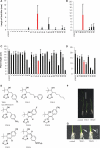A new lead chemical for strigolactone biosynthesis inhibitors
- PMID: 20522488
- PMCID: PMC2900822
- DOI: 10.1093/pcp/pcq077
A new lead chemical for strigolactone biosynthesis inhibitors
Abstract
Several triazole-containing chemicals have previously been shown to act as efficient inhibitors of cytochrome P450 monooxygenases. To discover a strigolactone biosynthesis inhibitor, we screened a chemical library of triazole derivatives to find chemicals that induce tiller bud outgrowth of rice seedlings. We discovered a triazole-type chemical, TIS13 [2,2-dimethyl-7-phenoxy-4-(1H-1,2,4-triazol-1-yl)heptan-3-ol], which induced outgrowth of second tiller buds of wild-type seedlings, as observed for non-treated strigolactone-deficient d10 mutant seedlings. TIS13 treatment reduced strigolactone levels in both roots and root exudates in a concentration-dependent manner. Co-application of GR24, a synthetic strigolactone, with TIS13 canceled the TIS13-induced tiller bud outgrowth. Taken together, these results indicate that TIS13 inhibits strigolactone biosynthesis in rice seedlings. We propose that TIS13 is a new lead compound for the development of specific strigolactone biosynthesis inhibitors.
Figures




Similar articles
-
Effects of triazole derivatives on strigolactone levels and growth retardation in rice.PLoS One. 2011;6(7):e21723. doi: 10.1371/journal.pone.0021723. Epub 2011 Jul 8. PLoS One. 2011. PMID: 21760901 Free PMC article.
-
A strigolactone signal is required for adventitious root formation in rice.Ann Bot. 2015 Jun;115(7):1155-62. doi: 10.1093/aob/mcv052. Epub 2015 Apr 17. Ann Bot. 2015. PMID: 25888593 Free PMC article.
-
DWARF27, an iron-containing protein required for the biosynthesis of strigolactones, regulates rice tiller bud outgrowth.Plant Cell. 2009 May;21(5):1512-25. doi: 10.1105/tpc.109.065987. Epub 2009 May 26. Plant Cell. 2009. PMID: 19470589 Free PMC article.
-
New genes in the strigolactone-related shoot branching pathway.Curr Opin Plant Biol. 2010 Feb;13(1):34-9. doi: 10.1016/j.pbi.2009.10.003. Epub 2009 Nov 11. Curr Opin Plant Biol. 2010. PMID: 19913454 Review.
-
The Whats, the Wheres and the Hows of strigolactone action in the roots.Planta. 2016 Jun;243(6):1327-37. doi: 10.1007/s00425-016-2483-9. Epub 2016 Feb 19. Planta. 2016. PMID: 26895337 Review.
Cited by
-
Target sites for chemical regulation of strigolactone signaling.Front Plant Sci. 2014 Nov 5;5:623. doi: 10.3389/fpls.2014.00623. eCollection 2014. Front Plant Sci. 2014. PMID: 25414720 Free PMC article. Review.
-
Effects of strigolactone-biosynthesis inhibitor TIS108 on Arabidopsis.Plant Signal Behav. 2013 May;8(5):e24193. doi: 10.4161/psb.24193. Epub 2013 Mar 19. Plant Signal Behav. 2013. PMID: 23511201 Free PMC article.
-
Fenoxycarb, a carbamate insect growth regulator, inhibits brassinosteroid action.J Pestic Sci. 2023 Aug 20;48(3):107-110. doi: 10.1584/jpestics.D23-015. J Pestic Sci. 2023. PMID: 37745175 Free PMC article.
-
Effects of gibberellin and strigolactone on rice tiller bud growth.J Pestic Sci. 2018 Aug 20;43(3):220-223. doi: 10.1584/jpestics.D18-013. J Pestic Sci. 2018. PMID: 30363138 Free PMC article.
-
Insect growth regulators with hydrazide moiety inhibit strigolactone biosynthesis in rice.J Pestic Sci. 2022 Feb 20;47(1):43-46. doi: 10.1584/jpestics.D21-063. J Pestic Sci. 2022. PMID: 35414758 Free PMC article.
References
-
- Akiyama K., Matsuzaki K., Hayashi H. Plant sesquiterpenes induce hyphal branching in arbuscular mycorrhizal fungi. Nature. 2005;435:824–827. - PubMed
-
- Arite T., Iwata H., Ohshima K., Maekawa M., Nakajima M., Kojima M., et al. DWARF10, an RMS1/MAX4/DAD1 ortholog, controls lateral bud outgrowth in rice. Plant J. 2007;51:1019–1029. - PubMed
-
- Asami T., Nakano T., Nakashita H., Sekimata K., Shimada Y., Yoshida S. The influence of chemical genetics on plant science: shedding light on functions and mechanism of action of brassinosteroids using biosynthesis inhibitors. J. Plant Growth Regul. 2003;22:336–349. - PubMed
-
- Beveridge C.A., Kyozuka J. New genes in the strigolactone-related shoot branching pathway. Curr. Opin. Plant Biol. 2010;13:34–39. - PubMed
Publication types
MeSH terms
Substances
LinkOut - more resources
Full Text Sources
Other Literature Sources

